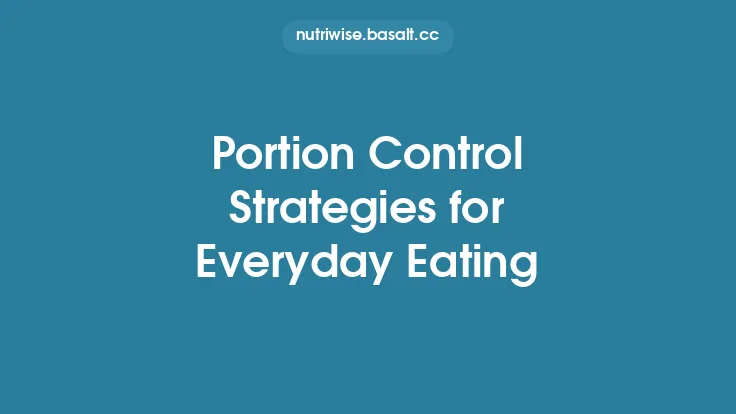Portion control is one of the most reliable levers for managing body weight without resorting to drastic diets or extreme restrictions. By making small, consistent adjustments to the amount of food you place on your plate, you can create a sustainable energy balance that supports gradual, healthy weight loss or maintenance. Below are practical, everyday strategies that can be woven into a typical routine, helping you keep portions in check while still enjoying the foods you love.
Building a Portion‑Control Routine
A routine is the backbone of any lasting habit. When it comes to portion control, the goal is to embed a series of predictable actions into your day so that the “right” amount of food becomes the default rather than a conscious decision each meal.
- Set a Consistent Meal Schedule – Eating at roughly the same times each day reduces the temptation to graze between meals, which often leads to unintentional over‑consumption. Aim for three main meals and, if needed, one or two planned snacks.
- Define Your “Standard” Plate – Choose a plate size that you will use for most meals (e.g., a 9‑inch dinner plate). By always using the same plate, you create a visual baseline that helps you gauge portion size without needing to count calories each time.
- Create a “Portion Blueprint” – Write down a simple template for each meal, such as:
- Protein – 1 palm‑sized portion
- Starch/Grain – ½ cup cooked or a fist‑sized portion
- Vegetables – 2‑3 fist‑sized portions
This blueprint can be printed and kept on the fridge for quick reference.
- Batch‑Prep Core Components – Cook a batch of a staple protein (e.g., chicken breast, beans) and a batch of a complex carbohydrate (e.g., quinoa, brown rice) at the start of the week. Store them in individual containers that match your blueprint, so assembling a meal becomes a matter of grabbing pre‑measured portions.
Prepping and Packaging for Success
The way food is stored can dramatically influence how much you end up eating. By pre‑portioning foods before they sit in the fridge or pantry, you remove the “guesswork” that often leads to larger servings.
- Individual Snack Packs – Portion out nuts, dried fruit, or whole‑grain crackers into small zip‑top bags or reusable snack containers. When a craving hits, you reach for a single pack rather than a bulk container.
- Portion‑Sized Freezer Meals – Assemble complete meals in freezer‑safe containers that match your blueprint. Label each with the date and contents. When you reheat, you already have a balanced portion ready to go.
- Use Transparent Containers – Clear containers let you see exactly how much is inside, reducing the temptation to “just have a little more.” They also make it easier to track leftovers.
- Label with Dates and Portion Info – A quick label that reads “1 cup cooked quinoa” or “1 palm protein” reinforces the correct serving size each time you open the container.
Grocery Shopping Strategies to Keep Portions in Check
The choices you make at the store set the stage for what ends up on your plate. Small adjustments during shopping can prevent portion creep before you even start cooking.
- Shop the Perimeter First – Fresh produce, lean proteins, and dairy are typically located along the store’s outer edges. By focusing on these sections, you naturally gravitate toward whole foods that are easier to portion.
- Buy in Bulk, Portion at Home – Purchasing items like grains, beans, or nuts in larger bags can be cost‑effective, but immediately transfer them into smaller, portion‑ready containers once home.
- Avoid Pre‑Portioned Packages When Not Needed – While single‑serve items can be convenient, they are often more expensive per unit. If you’re comfortable portioning at home, buying larger packages and dividing them yourself can save money and reduce packaging waste.
- Create a Shopping List Aligned with Your Blueprint – Write down the exact quantities you need for the week (e.g., “2 chicken breasts,” “3 cups quinoa”). Stick to the list to avoid impulse buys that can lead to extra calories.
Managing Portions When Eating Out
Dining at restaurants presents a unique challenge because portions are frequently larger than what you would serve at home. The following tactics help you stay on track without feeling deprived.
- Ask for a Half‑Portion or “Half‑Size” – Many establishments are willing to serve a smaller portion of a main dish upon request. If not, you can ask for a to‑go box at the start of the meal and immediately set aside half of the entrée.
- Start with a Salad or Soup – A low‑calorie starter can fill you up enough to reduce the amount you eat of the main course. Choose broth‑based soups or salads with vinaigrette rather than creamy dressings.
- Share an Entrée – Splitting a main dish with a dining companion instantly halves the portion size while still allowing you to enjoy the restaurant’s flavors.
- Control the Bread Basket – If a basket of bread is offered, limit yourself to one piece. Place the rest on the table and step away to avoid mindless nibbling.
- Mind the Extras – Sauces, gravies, and cheese can add hidden calories. Request them on the side so you can control how much you actually use.
Controlling Extras: Sauces, Dressings, and Cooking Fats
Even when the main components of a meal are properly portioned, the “extras” can quickly tip the calorie balance.
- Measure Before Adding – Use a teaspoon or a small measuring spoon to portion out oil, butter, or sauces before they hit the pan or plate. This prevents the habit of “just a drizzle,” which can be more than a tablespoon.
- Opt for Low‑Calorie Alternatives – Replace heavy cream sauces with tomato‑based or broth‑based options. Use mustard, lemon juice, or a splash of vinegar instead of creamy dressings.
- Keep a “Sauce Station” – Store pre‑measured portions of your favorite sauces in small containers (e.g., 1‑tablespoon servings of pesto). When you need flavor, you have a controlled amount ready.
- Use Non‑Stick Cookware – A good non‑stick pan reduces the need for added fats during sautéing or frying, allowing you to achieve the same texture with less oil.
Smart Snacking: Portioning Snacks Ahead of Time
Snacks are often the hidden source of excess calories, especially when they come from a large, open bag. Planning ahead can keep snack portions in line with your goals.
- Pre‑Portion Fruit – Wash and cut fruit (e.g., apple slices, berries) into single‑serve containers. This makes fruit as convenient as a bag of chips.
- Create “Snack Kits” – Combine a protein (e.g., a hard‑boiled egg or a slice of cheese) with a fiber source (e.g., carrot sticks, whole‑grain crackers) in a small container. The balanced combo helps curb hunger longer.
- Set a “Snack Window” – Designate a specific time window for snacking (e.g., 10 am–11 am). This reduces the likelihood of grazing throughout the day.
- Use Portion‑Control Apps – Many nutrition apps let you log snack items and automatically calculate the portion size based on your input. This can be a quick way to stay accountable.
Using Technology to Support Portion Management
Digital tools can simplify the process of tracking and adjusting portions without adding extra mental load.
- Food‑Logging Apps – Apps such as MyFitnessPal, Cronometer, or Lose It! allow you to scan barcodes or search for foods, then log the exact amount you ate. Over time, the data reveals patterns you can tweak.
- Smart Kitchen Scales – While the article on measuring without a scale is off‑limits, a digital scale that syncs with an app can provide precise data for those who want it, especially for baking or portioning high‑calorie items.
- Meal‑Planning Software – Programs like Mealime or Paprika let you build weekly menus based on your portion blueprint, automatically generating shopping lists that match your intended servings.
- Reminder Systems – Set phone or smartwatch reminders for meal times, snack windows, or “portion check” prompts (e.g., “Did you portion your dinner?”). Consistent nudges reinforce the habit loop.
Tracking and Adjusting Over Time
Even the best‑planned portion strategy benefits from periodic review. Small, data‑driven tweaks keep progress moving forward.
- Weekly Check‑In – At the end of each week, review your food logs or app summaries. Look for trends such as “I consistently exceed my snack portion on Fridays” and plan a corrective action.
- Weight and Measurement Monitoring – Track weight, waist circumference, or how your clothes fit on a regular basis (e.g., every two weeks). If you notice a plateau, consider tightening portion sizes by 5‑10 % for a short period.
- Adjust for Lifestyle Changes – When travel, holidays, or schedule shifts occur, temporarily modify your portion blueprint to accommodate new circumstances (e.g., larger meals at a family gathering). Return to your standard portions once the event passes.
- Celebrate Small Wins – Recognize achievements like “I stuck to my snack portions for a full month.” Positive reinforcement helps sustain long‑term adherence.
Overcoming Common Everyday Challenges
Even with a solid plan, real life throws curveballs. Below are solutions to frequent obstacles that can derail portion control.
- Busy Mornings – Prepare grab‑and‑go breakfast portions (e.g., overnight oats in a mason jar) the night before. Having a ready‑made portion eliminates the temptation to skip breakfast or eat an oversized portion later.
- Emotional Eating – Keep a “comfort‑food” stash of portion‑controlled treats (e.g., a single‑serve dark‑chocolate square) that you can turn to instead of larger, unplanned indulgences.
- Family Meals – Serve yourself first, using your portion blueprint, then place your plate on the table. This prevents you from automatically taking a second helping when everyone else is refilling.
- Limited Kitchen Space – If storage is tight, focus on a few versatile containers that can be reused for multiple foods (e.g., a 1‑cup container for both cooked grains and chopped vegetables).
- Social Pressure – Politely decline “just one more bite” offers by stating you’re following a portion plan. Most friends will respect your commitment when you explain it simply.
Summary and Takeaways
Portion control does not require a radical overhaul of your diet; it is about embedding a series of manageable, repeatable actions into everyday life. By establishing a consistent routine, pre‑portioning foods, making strategic choices while shopping and dining out, controlling the hidden calories in sauces and fats, and leveraging technology for tracking, you create a robust framework that supports weight management over the long term. Regular review and flexible adjustments ensure the system stays aligned with your evolving lifestyle, while practical solutions to common challenges keep you on track when life gets busy. Implement these everyday tactics, and you’ll find that maintaining a healthy weight becomes a natural, sustainable part of your daily rhythm.





